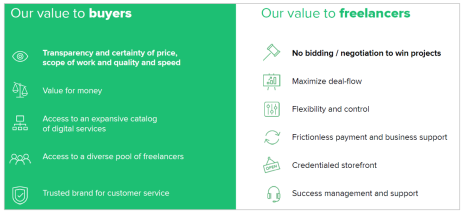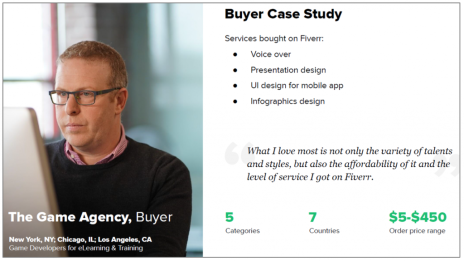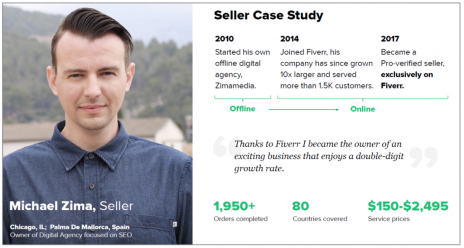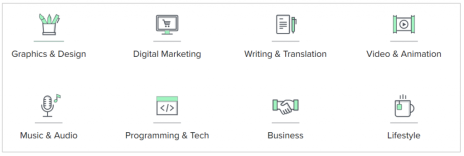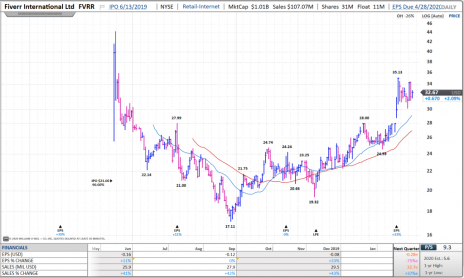This month we’re jumping into a software company that’s developed an innovative product for the emerging gig economy. But it’s not another Airbnb, Lyft or Uber. No apartments for rent or cars for hire here.
Rather, just like eBay and Etsy have created online marketplaces for buyers and sellers of physical goods, this company has created a marketplace that matches buyers and sellers of digital services—things like graphic design, writing and web development.
As the gig economy explodes this company is poised to enjoy rapid growth. And while no company is inoculated from the coronavirus, this one has some protection since it’s part of the digital, not physical, economy.
Cabot Small Cap Confidential 250
[premium_html_toc post_id="199674"]
The Big Idea
Any time you have a fragmented market where there are a lot of buyers and sellers that have a hard time getting together there is an opportunity for a software-enabled marketplace to grease the wheels of commerce.
We’ve seen this concept work in emerging markets, like insurance shopping. Just look at portfolio holding EverQuote (EVER), which is relatively early in its growth trajectory (we hope).
And we’ve seen it work exceedingly well in more mature markets, like travel and hotel booking, and buying all manner of knicknacks and used items. Witness the relative long-term success of Expedia (EXPE), Etsy (ETSY) and eBay (EBAY).
Today we’re looking at a company trying to disrupt a new market—specifically, the huge and fragmented digital freelance worker market, which has myriad logistical challenges.
This market is estimated to top $750 billion a year in just the U.S.
The global opportunity is much larger, albeit more difficult to quantify. A lot of digital freelance work can happen across borders without being easily tracked.
The keys to success in disrupting this market are to create a technology platform that’s easy to use for both buyers and sellers, focus on projects that are well-suited to being conducted online, and build out a platform with features and tools that handle all the hassles that traditionally come with freelance work—things like communication, payments, contracts, etc.
Finally, adding algorithms and machine learning capabilities that match up buyers and sellers, and a way to create and read authentic reviews, are crucial.
One company has done all this already. It already has over 2.4 million active buyers and offers 300 categories of services.
Revenue growth topped 40% in 2019. And with growing scale the company is trending toward first profits in 2022.
Already, it’s a remarkable growth story. But I think the best is yet to come as this company adds products and services to better leverage the growth potential of the gig economy.
The Company
Fiverr International (FVRR) is a $1 billion market cap company that has developed an innovative online marketplace that matches freelancer workers with buyers using a Service-as-a-Product (SaaP) business model. This transactional marketplace lists Gigs, or projects, just like an online marketplace like eBay and Etsy list physical goods; in a catalogue that buyers can search, browse and purchase from.
Gigs range in price from as little as $5 to over $10,000. As you might expect most customers are smaller, with fewer than 15 employees. But Fiverr has made inroads expanding upmarket and sees a pathway to gain more customers with up to 200 employees.
Listed services are primarily limited to those that can be transferred digitally. There are very few physical goods for sale here. Fiverr is a marketplace for things like writing, animation, digital marketing services, music and video editing, and graphic design. Altogether, the company is focused on services that amount to roughly $125 billion of the $750 billion U.S. market for freelance work.
The company was founded in 2010 in Tel Aviv, Israel and remains headquartered there today. The founders, Micha Kaufman and Shai Wininger, came up with the idea based on personal experiences working with freelancers. They had the creativity and technical aptitude to create an on-demand, e-commerce-like experience that makes booking a freelancer almost as easy as purchasing from Amazon.
While online marketplaces for physical good are a proven business model, it’s not quite the same for services. At least not yet. Investing in Fiverr is placing a bet that this concept can take off in the freelance market.
It’s a good place to start given market characteristics that are similar to other markets where an online marketplace has worked. The freelance market is large, fragmented, time consuming for all parties involved, often opaque in terms of quality, trust, pricing and payment terms, and offers limited scale for both buyers and sellers.
Fiverr changes all that. It’s specifically for digital services, so there’s no physical product to transport. It’s on-demand, so there is no long-term commitment or hiring. It’s global, so buyers and freelancers have a huge pool of potential people to work with. And the platform handles all the pricing, payment and details, including reviews and transaction history, so both parties can focus on the job, not the peripheral details.
For all of this Fiverr takes a 25% cut (the “take rate”). As a point of reference, that take rate is roughly in line with Lyft, and roughly 4% to 5% more than eBay and GrubHub. It’s about 10% more than Etsy.
While the average amount per Gig is relatively small – just $170 in Q4 2019 – it is consistently going up (up 17% in Q4). And with 2.4 million active users, and growing (up 17% in Q4), the platform is beginning to gain meaningful scale.
Revenue grew by over 40% in both 2018 and 2019. And on its current trajectory growth should top 30% in 2020. Fiverr should also be profitable in two years. But should any of the company’s several growth initiatives work out better than expected the numbers could easily go up.
The Product
Fiverr’s marketplace is a very simple concept. Sellers create a profile then list their service offerings on the marketplace. Each Gig is defined in terms of work scope, time of delivery, price and other relevant details. There are millions of Gigs on Fiverr. Buyers search through the online catalog and find the one they want.
The buyer then places the order and pays the Gig’s stated price, plus a 5% service fee. If a Gig costs less than $40 there is a flat service fee of $2. As soon as the order is placed the platform prompts the buyer to send the seller the relevant files as required by the Gig description, along with an instructional brief. The seller can start once these materials are received. Communication between buyer and seller can then happen on the Fiverr platform.
The platform allows 14 days to complete the project, at which time, if the buyer has reported no issues, Fiverr passes 80% of the Gig value on to the seller. For example, if a buyer places an order for a $100 gig, they are charged $105. After 14 days, the seller gets paid $80. Fiverr gets $25.
What can sellers sell and what can buyers buy?
A lot. Fiverr’s marketplace is organized into eight core verticals. Within each vertical (see image below) there are numerous categories, such as logo design, game design, resume writing, logo animation, mobile apps, business presentations, and web programming. Altogether, the platform offers well over 300 categories of services, and growing.
Growth Initiatives
Fiverr is pushing on many levers to keep growth alive and capitalize on the opportunity in front of it. This is just a little of what’s going on behind the scenes.
Move Upmarket: Most of Fiverr’s current 2.4 million active buyers are entrepreneurs and small businesses with less than 15 employees. It sees huge opportunity to expand into small businesses with up to 200 employees. It is building out products to accommodate the types of projects these organizations need, and starting targeted advertising campaigns at this market segment. With high-value buyers representing 52% and 53% of revenue in the last two quarters, respectively, it appears Fiverr is making progress.
International Expansion: Fiverr is currently in over 160 countries but 70% of revenue is still generated from English-speaking locations. To expand, management has recently launched two localized websites for German and Spanish speaking customers. It has near-term plans to convert all user-generated content to local languages too, and fire up localized marketing campaigns to keep the international push going.
Expand Categories and Enhance the Platform: Fiverr has been adding new products to attract larger customers, such as Fiverr Studios (virtual collaboration for larger projects), Team Accounts (for team collaboration) and Fiverr VID (dedicated support for high value buyers). It is also making product enhancments featuring AI, big data and machine learnings, which should better connect buyers and sellers.
The Business Model
Fiverr is a marketplace that matches buyers and sellers. Accordingly, the company generates revenue from transaction-based fees of 25% per Gig (order). There are a few additional fees (currency, etc.) that brought the average take rate up to 26.7% in Q4 2019. It may go up modestly in 2020. If you multiply the take rate by the gross merchandise value (GMV) passing through Fiverr’s platform, you get revenue. Because the company is incentivized to increase GMV, i.e. the volume and dollar amount of Gigs, and that is a function of attracting more (and repeat) buyers and sellers, Fiverr must try and keep its take rate reasonable.
The Bottom Line
Fiverr grew revenue by 45% in 2018 and by 42%, to $107.1 million, in 2019. The company is not profitable but is reducing losses. It delivered adjusted EPS of -$0.52 in 2019 (a 20% improvement over 2018). In Q4 2019, reported on February 19, the company grew revenue by 43%, to $29.5 million and reduced its adjusted EPS loss by 50%, to -$0.08. Most important finanical metrics continued to improve in Q4 as well, including active buyers and spend per buyer both growing by 17% (to 2.4 million and $170, respectively) and take rate increasing to 26.7% from 25.7%. Fiverr ended the quarter with $112.7 million in cash, cash equivalents and marketable securities and no debt.
Management provided initial 2020 guidance that calls for revenue growth of 30% to 32% ($139 million to $141 million). This likely leaves room to beat. We are also looking for continued progess toward break even in 2022, with 2020 adjusted EPS improving by 43% to -$0.33.
Risk
Market May Not Develop As Expected: While the global market for freelance work is large there may be reluctance for market participants to move online and give a cut of deal value to Fiverr.
Profitability May Take Longer to Achieve: We’re looking for first profits in 2022, and potentially sooner if Fiverr grows faster than consensus expectations. But if profitability is pushed back the stock could suffer.
Increased Competition: Fiverr appears to be succeeding where others in this market, like Upwork, are failing. But success attracts new entrants. Larger competitors with more resources could impact Fiverr’s growth. That said, they could also see the company as a nice acquisition target to give them an immediate leadership position in an attractive market.
Take Rate Pressure: Fiverr’s take rate of roughly 26% could be impacted if there is enough pressure on the company from sellers (who contribute 20%) and buyers (who contribute 5%).
Growth Initiative Stumble: Fiverr is still a relatively young company and is making a lot of upgrades and improvements to build out the platform, both domestically and abroad. A misstep here or there is one thing, but if management drops the ball in several areas all at once there could be a material impact on growth expectations.
Coronavirus Fear: Everybody is wondering what the deal is here and it may be serious, or way overblown. Bottom line: If people continue to freak out there will likely be a slowdown in business activity. This could hurt Fiverr. On the other hand, it could help as more people could be forced to work remotely rather than in person. We’ll just have to see.
Competition
Most competition comes in the form of freelancers doing business both online and offline on their own, which still represents the bulk of the market. Staffing services also represent competition. There are also a few public companies doing similar things as Fiverr, including Upwork (UPWK), which offers more of a staffing model, and Freelancer, which is an Australian firm. Neither of these competitors are doing so hot, potentially because Fiverr is gaining scale.
The Stock
Trading Volume: Fiverr International has a market cap of $1 billion and trades an average of 310,000 shares daily. That means roughly $9.87 million worth of stock trades each day. While it’s unlikely that our subscriber group will move this stock it’s still wise to consider that potential if there is a significant movement in shares after this Issue is published. Big volume days are 500,000 shares or more. That’s occurred less than 10 times over the last six months. Two of the biggest days, roughly 2 million shares each, occurred after Q4 earnings came out. That’s a big indication of high demand.
Historical Price: FVRR went public at 21 in June 2019 and surged 90% on its first day. By late September (when the market was in the dumps) shares were below their IPO price. They bottomed near 17 jumped into the low 20s in October, then briefly dipped below 20 around lockup expiration in mid-December. Shares then began to climb steadily and reached 28 in late January. A short-lived dip preceded the Q4 earnings release, after which FVRR shot as high as 35. The stock has settled down to trade in the low 30s since.
Valuation & Projected Price Target: Fiverr should see its multiple rise given the revenue growth rate and if/as it approaches profitability, and confidence in the business model grows. It currently trades at an EV/Forward Revenue multiple of 6.2. If we assume that can increase to 8.5 (all else being equal), the stock would have roughly 40% upside potential. Accordingly, let’s start with a 12-month price target of 45.
Buy Range (next two months): FVRR looks like a good buy between 30 and 34, which is where it’s traded since Q4 earnings came out a couple weeks ago. The stock would remain a buy down to around 28, where it was prior to reporting, provided no negative fundamental change to the business. If shares get above 36 in the near-term, without any meaningful increase in guidance, I would be more cautious about buying.
The Next Event: No events announced.
Fiverr International (FVRR 32.93)
Tel Aviv, Israel
www.fiverr.com
| Fiverr International Financials | |||||
| March 5, 2020 | |||||
| Market Cap ($million) | 1,010 | ||||
| Enterprise Value ($million) | 882 | ||||
| Industry | Retail - Internet | ||||
| Fiscal Year Ends | December 31, 2020 | ||||
| Average Daily Volume | 310,000 | ||||
| Sales TTM ($million) | 107.1 | ||||
| Adjusted EPS TTM ($) | -0.52 | ||||
| Profit Margin TTM (%gross) | 81.0 | ||||
| Net Debt ($million) | -127.7 | ||||
| Diluted Shares Outstanding (million) | 31.9 | ||||
| P/E Ratio (forward) | N/A | ||||
| EV/Sales (forward) | 6.2 | ||||
| Historical & Forward Revenue and EPS Estimates (Consensus) | |||||
| Quarterly Revenue ($million) | Q1 | Q2 | Q3 | Q4 | Year |
| 2020 | 141.0E | ||||
| 2019 | 23.8 | 25.9 | 27.9 | 29.5 | 107.1 |
| 2018 | 16.7 | 18.4 | 19.7 | 20.7 | 75.5 |
| Adjusted Earnings Per Share ($) | |||||
| 2020 | -0.33E | ||||
| 2019 | -0.16 | -0.16 | -0.12 | -0.08 | -0.52 |
| 2018 | -0.23 | -0.18 | -0.12 | -0.12 | -0.65 |
Updates on Current Recommendations
| Stock Name | Date Bought | Price Bought | Price on 3/04/20 | Profit | Rating |
| AppFolio (APPF) | 6/2/17 | 30.45 | 120.02 | 294% | Hold |
| Arena Pharmaceuticals (ARNA) | 2/2/18 | 38.93 | 49.95 | 28% | Buy |
| Avalara (AVLR) | 2/1/19 | 40.05 | 84.13 | 110% | Buy |
| Cardlytics Inc (CDLX) | 9/6/19 | 37.97 | 54.55 | 44% | Hold |
| Domo Inc (DOMO) | 5/3/19 | 36.28 | 20.14 | -44% | Hold |
| Everbridge (EVBG) | 12/2/16 | 15.51 | 109.30 | 605% | Hold |
| EverQuote (EVER) | 6/7/19 | 11.69 | 39.15 | 235% | Hold 1/2 |
| Fiverr Intl (FVRR) | New | — | 32.93 | — | Buy |
| Goosehead Insurance (GSHD) | 9/7/18 | 31.35 | 62.40 | 99% | Hold |
| Health Catalyst (HCAT) | 12/6/19 | 40.67 | 30.16 | -26% | Hold |
| Inspire Medical (INSP) | 10/4/19 | 58.54 | 88.98 | 52% | Hold |
| Luna (LUNA) | 2/7/20 | 8.35 | 7.19 | -14% | Buy |
| Model N (MODN) | 1/3/20 | 34.95 | 29.37 | -16% | Buy |
| Q2 Holdings (QTWO) | 4/1/16 | 23.81 | 76.20 | 220% | Buy |
| Repligen (RGEN) | 11/2/18 and 12/31/18 | 59.19 | 94.17 | 59% | Buy |
Glossary
Buy means accumulate shares at or around the current price.
Hold means just that; hold what you have. Don’t buy, or sell, shares.
Sell means the original reasons for buying the stock no longer apply, and I recommend exiting the position.
Sell a Half means it’s time to take partial profits. Sell half (or whatever portion feels right to you) to lock in a gain, and hold on to the rest until another ratings change is issued.
Please email me at tyler@cabotwealth.com with any questions or comments about any of our stocks, or anything else on your mind.
The next Cabot Small-Cap Confidential issue is scheduled for April 2, 2020.
Cabot Wealth Network
Publishing independent investment advice since 1970.
CEO & Chief Investment Strategist: Timothy Lutts
President & Publisher: Ed Coburn
176 North Street, PO Box 2049, Salem, MA 01970 USA
800-326-8826 | support@cabotwealth.com | CabotWealth.com
Copyright © 2020. All rights reserved. Copying or electronic transmission of this information is a violation of copyright law. For the protection of our subscribers, copyright violations will result in immediate termination of all subscriptions without refund. No Conflicts: Cabot Wealth Network exists to serve you, our readers. We derive 100% of our revenue, or close to it, from selling subscriptions to its publications. Neither Cabot Wealth Network nor our employees are compensated in any way by the companies whose stocks we recommend or providers of associated financial services. Disclaimer: Sources of information are believed to be reliable but they are not guaranteed to be complete or error-free. Recommendations, opinions or suggestions are given with the understanding that subscribers acting on information assume all risks involved. Buy/Sell Recommendations: All recommendations are made in regular issues or email alerts or updates and posted on the private subscriber web page. Performance: The performance of this portfolio is determined using the midpoint of the high and low on the day following the recommendation. Cabot’s policy is to sell any stock that shows a loss of 20% in a bull market or 15% in a bear market from the original purchase price, calculated using the current closing price. Subscribers should apply loss limits based on their own personal purchase prices.



